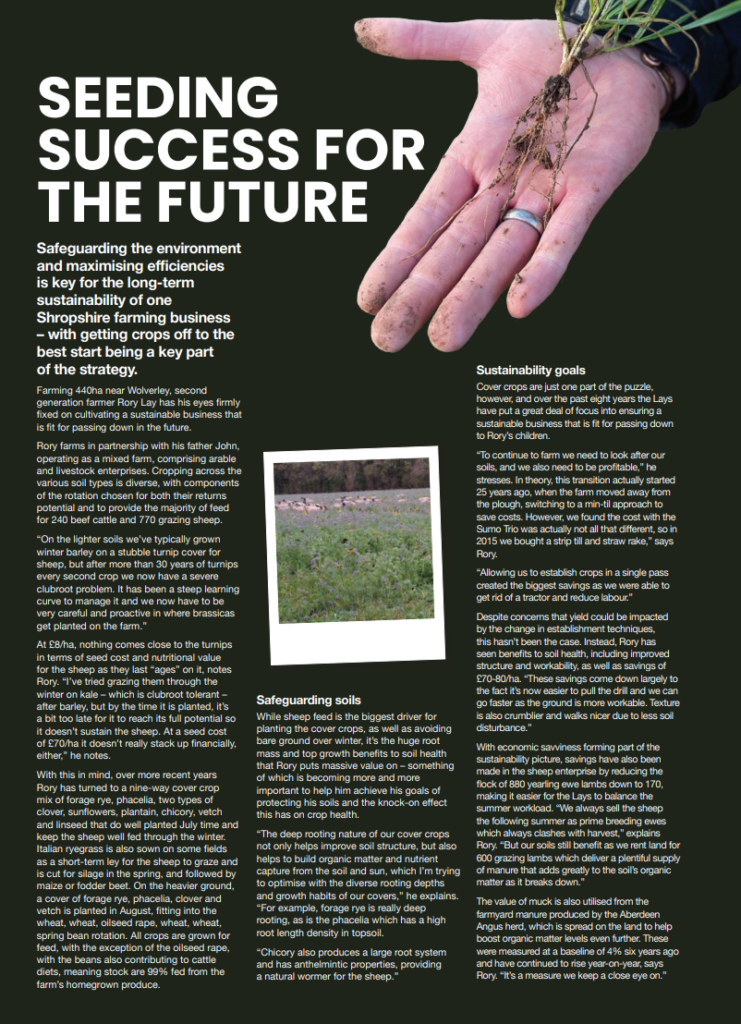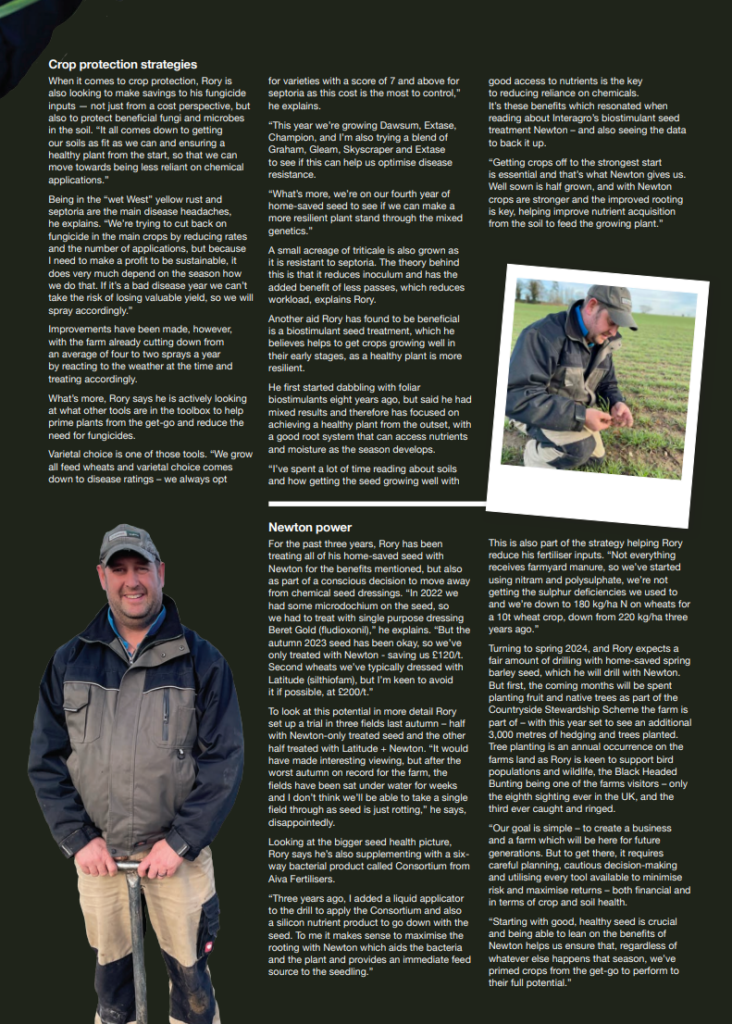The landscape of farming is ever evolving, with new challenges continually giving reason to pause, assess the strategy and adapt to remain resilient in the face of adversity.
Continual challenge has certainly been the theme over recent years, with growers facing everything from environmental pressures, climatic changes, and the loss of key chemistry from the crop protection armoury, all making day-to-day operations trickier. As such many growers are now looking at what else they can bring into crop management to help support production, which has driven a sharp increase in interest in biostimulant products over recent years.
With biostimulants claimed to offer a plethora of benefits, from enhanced nutrient uptake, root development, and plant hormone synthesis, leading to increased yields and improved crop characteristics, as farmers seek ways to optimise their production and meet market demands, the potential benefits of biostimulants have garnered attention, explains Andy Barker, research agronomist at Barworth Research Ltd. “The term biostimulant could cover much – from fertiliser to water.
We founded the company in 2008 and our driver has been to further the use of bacteria and fungi into broadacre agriculture, which certainly back then was quite niche. “Then, as the larger agchem companies began to bring microbial and plant derived products into the market place, we started to see greater interest, but until then biostimulants were a bit ‘fringe’ – in the UK anyway.”

Finding a place in farming
So where do biostimulants now fit in this changing climate? Specifically talking about foliar applied and seed treatment biostimulants, particularly those from naturally derived sources, Andy says there’s now a lot more interest from both growers at farm level and those higher up the supply chain. So why is this? A declining armoury of chemistry is a key reason, believes Scottish Agronomy’s Adam Christie. “The conventional pipeline of crop protection products isn’t nearly as strong as it once was and as such, there has been a significant upshot in interest in bio products,” he explains.
“We always keep copies of the green pesticide book in the office, and it gets slimmer and slimmer every year. It’s very obvious that our pesticide choices aren’t what they once were. “The days of going into a spray store and finding a product to cure all ills is long gone.”
Quest for efficiency
Nitrogen use efficiency – and making a conscious effort to reduce reliance on nitrogen — is another driver. “The industry is not quite as obsessed with nitrogen as we were two or three years ago, but it’s still £300/t and a significant spend, so ensuring the efficiency of every application is a big priority for a lot of growers,” says Adam.
Environmental advantages
With a growing emphasis on sustainable agriculture and reducing the environmental impact of farming practices, some biostimulants can help aid the sustainability of operations by improving nutrient efficiency and reducing nutrient runoff.
This is where the supply chain is particularly interested too, notes Andy. “I think commercially, some of the interest in biostimulants is being driven from the supermarkets upwards. Behind closed doors they’re asking questions about what is being done to reduce chemical fertiliser inputs, for example.

“Building on the theme of environmental challenges, in the form of climate change with increased frequency of extreme weather events, growers are looking into biostimulants as one possible avenue to help ‘soften’ the blow. “Looking at the weather this winter for example, some of the fields around where I am are not going to be dry enough to do anything with until March at this rate. So, I think lots of farmers are trying to see what else is out there to help crops cope better.”
Investment in research
Another driver in uptake comes as a result of an investment in more scientific research on biostimulants, highlighting their potential benefits and efficacy in enhancing plant growth and stress tolerance. The availability of scientific evidence and advancements in understanding the mechanisms of biostimulants have contributed to increased confidence in their use among farmers.
“Historically, hesitancy with regards to uptake of the use of biostimulants comes down to inconsistent results,” says Adam. “Though that is improving due to more investment in trials and research, there is still a lot to learn. “We’re on a learning journey at the moment and getting the best out of biologicals will come with learning exactly how they do and don’t work.
“I think a lot of people have also seen them as a replacement for pesticides and used them at the same timings, but we’ve actually found best results when they’re used early in the growing season to prime the crop. Andy concurs: “Particularly with some of these foliar products, we do see a response where they’re applied – particularly if there’s a reason for doing so, like crop stress, and we can get on early, before it’s too late.
We get to choose who we play with, and what we can say is that we’ve seen a response with Interagro’s products in trials.” Adam picks up the conversation and points out that Interagro’s Bridgeway is an example of a product which has definitely got something about it.
“We’re doing work at the moment to better understand that, but what we do know is that a healthier plant has a better chance of fighting off disease. “We’ve also seen evidence that in some circumstances the seed treatment Newton can benefit seed establishment. Especially with the challenging conditions we’ve had trying to drill over the past four months – and who knows what the spring is going to be like — anything we can do to help a seed in a challenging seed bed is going to be welcome.”

Among the research bodies looking into the full scope of biostimulants is Dyson Farming Research. Dyson’s research focuses on developing innovative technologies and solutions to address the challenges faced by the agricultural industry and as such have explored the potential of biostimulants in improving crop health, nutrient efficiency, and overall sustainability.
Christine Jones heads up the potato side of the business. “We’ve been looking particularly at Bridgeway over the past few years to try and get an understanding of what it’s doing in the crop and how best to use it,” she explains. “In our trials, we’ve seen it act as a stress protectant in potato crops, meaning yield losses are reduced after periods of particularly hot and dry weather.
“We’ve seen fairly consistent results, and because we measure our crops right the way through the season, we’ve got a comprehensive understanding of how crops have behaved and how they’ve responded to the Bridgeway.” One of the experiments Christine has run showed better tuber bulking with Bridgeway after a pause due to crop stress. “By the end of the season, the result was that the yield loss was much less in the Bridgeway-treated plots.”
But Dyson’s ethos is not to look at just one season’s worth of results. “We want to know why something happened so we can better understand where we can use them in the future,” explains Christine. “With the increased risk of extreme weather conditions as the climate changes, it becomes more likely that potatoes are going to be experiencing hot and dry stress conditions, so we know that in this scenario, there’s going to be a much more likely response to the Bridgeway product.”
Future outlook Looking to the future, Christine says that getting the most out of biostimulants in an ever-changing environment will rely on knowing how and where to use individual products. “There are quite a wide range of products which come under the biostimulant banner so it’s important to know how to use them best, where they might give you complementary benefits alongside your usual approach or whether it’s something that is going to stimulate the plant to grow better.”
Andy concurs: “Over the past 12 months, there have been a rush of products coming into the marketplace, some of which we’ve tested in house and would say it’s a bit “horses for courses” – I think it’s important to be aware of products over-promising. But there are good and bad products out there.” Alternative tramlines are a good way to build up an accurate picture of the potential impact a biostimulant can have, he adds.
“This allows for differences from one end of the field to the other – different soil types, moisture, pH etc.” Adam believes the use of biostimulants is only going to increase over the coming years. “We’re going to have to utilise all the tools in the toolbox. “A lot of investment is being made in the market, so they’re products that should be taken seriously, but they also need to earn their place in the spray tank. However, products should be selected on proven merit, rather than just sentiment, and backed up with science. It’s really important that we don’t let sentiment overrule science.”


